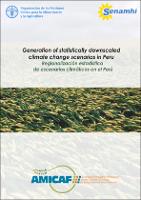Generation of statistically downscaled climate change scenarios in Peru
Fecha
2014Palabras clave
Cambio Climático - Temperatura del Aire - Precipitación - Statistical Downscaling - Inseguridad AlimentariaColecciones
Resumen
This report briefly describes how SENAMHI (http://www.senamhi.gob.pe/) obtained local projections of precipitation/
maximum/minimum temperature (daily data up to 2065) for 265/105/102 selected stations over Peru, needed for the completion of tasks within the Component I of the AMICAF project. In particular, an analog‐ (regression‐) based technique was applied to generate an ensemble of six ‘plausible’ projections of precipitation (temperatures), considering three different Earth System Models and two Representative Concentration Pathways. The tool used to this aim was the Statistical Downscaling Portal (https://www.meteo.unican.es/downscaling/intro.html) developed and maintained by Predictia Intelligent Data Solutions (http://www.predictia.es/en/home) and the Meteorology Group of the University of Cantabria (http://www.meteo.unican.es/en/main). The Component I of AMICAF Peru provides projections of precipitation/
maximum/mínimum temperature for 256/105/102 stations over Peru up to 2065, by means of statistical downscaling. An ensemble of six ‘plausible’ projections (3 ESMs × 2 RCPs) is considered for each target variable, which allows for a proper assessment of the uncertainties involved in this type of study. For the period 2036‐2065, results show a mean (for the entire country) increment (with respect to 1971‐ 2000) between C and C (C and C) for maximum (minimum) temperature. For precipitation, it is between 10% and 20%.
El ítem tiene asociados los siguientes ficheros de licencia:








